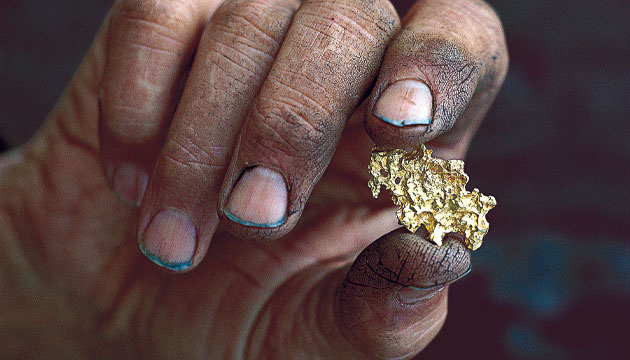From the tented mining fields of the 1850s to 21st century careers, from the youngest of children to the greyest of retirees, gold fever has infused Australian life.
Story Mandy McKeesick Photo Roger Garwood
The peace and quiet of the stringybark bush is shattered by a scream and a smile spreads across Paul Olsen’s face. It could be the start of a horror movie, but this is a golden tale.
Deep in Blair Athol State Forest, near Clermont in central Queensland, Paul is a gold hunter and the screams, squeals, double-beeps, whoo-wees and growls of his Minelab GPZ7000 detector are music to his ears. “My father stuck a gold pan in my hand when I was eight and I swung my first detector at 17,” he says of the gold fever that has gripped him his entire life. Now 57 and of no fixed address, Paul bases himself in Clermont, where he first arrived 28 years ago to be part of the gold adventure.
“Gold hides itself very well,” he says. “I’ve got to be the Sherlock Holmes of gold hunting.” And he is; though in place of a tweed coat and smoking pipe there is all the paraphernalia that adorns the modern gold prospector: harness, hip stick, coil control, transmitters, speakers, boosters, camelback for water, pick slung over his shoulder, plastic spade in a back pocket and, most importantly, a lucky gold bottle with reflective yellow tape. If you thought gold detecting was merely waving a stick over the ground, you would be mistaken.
“The detector is an audio rather than a visual machine and my ears have had 30 years of training,” Paul says. The GPZ7000 retails at close to $9500 and he is skilled in his chosen profession. “I’m that confident in my ability and the machine, I could pay it off in three months.”
Those skills include being a master at reading the landscape; of looking for the run of gullies, of interpreting workings left by miners 100 years ago, of recognising shallow soil by the mound at the base of an old tree. Paul then imagines how the heavy gold will work over a slope and how ancient waterways may have transported it, by looking for disturbed ground and old timers’ camps, spotting ironstone staining on quartz, and areas where trees, once cleared, are now regenerating. These are the skills of a true bushman.
Paul frequently finds reminders of gold seekers from another time – wiry spectacles, boot nails, metal buttons and coins – because the search for gold parallels Australia’s history. Gold has always promised riches but beyond wealth it has intangible allure, and with it comes mystery and legend.
The precious yellow element is one of the oldest known to man, having been recorded as far back as 4000 BC, and it is entwined in history and mythology.
Even the origins of gold have a mysterious allure – all accessible gold (that is gold not contained within the Earth’s molten core) is believed to be from space, arriving on our planet as part of an intense meteorite storm 200 million years after it was formed. Not that the meteorites brought a lot of the stuff. Gold remains one of the rarest metals known to mankind and scientists have estimated 5000 tonnes of dirt would only produce, on average, 20 grams of gold.
Its scarcity contributes to gold being an international monetary standard and an indicator of wealth. It is fashioned into jewellery, and used in dentistry and the manufacturing of electronics and medicine. Gold-coated visors protect the eyes of astronauts from harmful rays in space and gold can even be eaten; in 2016 Nestlé produced a 24-karat gold-covered KitKat to celebrate the Chinese New Year.
Gold is found throughout the outback in every state and territory, but the mother lode resides in Western Australia. According to statistics from the WA Department of Mines, Industry Regulation and Safety, the state dug up 212 tonnes of gold in 2017. If WA were a country, it would be the world’s fifth-largest gold producer.
The wealthiest part of Western Australia is the Golden Mile around Kalgoorlie, which Paddy Hannan stumbled upon in 1893. In May 2017, KCGM, the owners of the mammoth Kalgoorlie Super Pit, produced the 60-millionth Golden Mile ounce. The Super Pit is big and rich. It is 3.5 kilometres long, 1.5km wide and more than 500 metres deep, and KCGM can produce up to 800,000oz (22.6t) of gold per year. That’s the equivalent mass of more than 1600 cartons of beer.
This story excerpt is from Issue #123
Outback Magazine: February/March 2019









